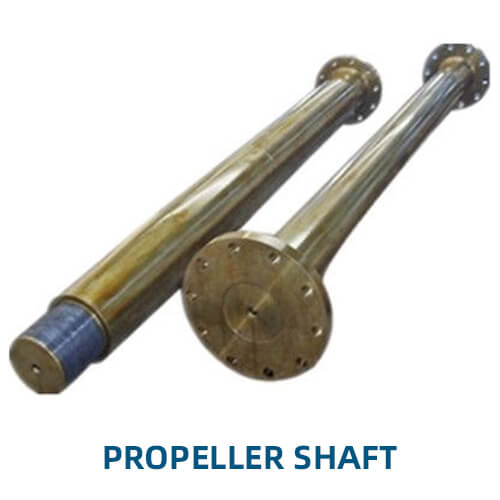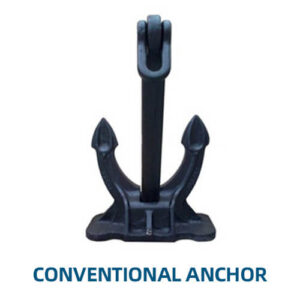Key Features of a Propeller Shaft:
- Design and Construction:
- Material: Propeller shafts are typically made from high-strength, corrosion-resistant materials such as stainless steel, nickel alloys, or titanium. These materials provide the durability needed to withstand the harsh marine environment, including saltwater exposure, mechanical stress, and varying temperatures.
- Sections: Depending on the vessel’s size and engine configuration, the propeller shaft may consist of several sections, including the intermediate shaft, the stern tube shaft, and the tail shaft. These sections are connected via couplings and are supported by bearings along the length of the shaft.
- Bearings: The shaft is supported by bearings, which are crucial for minimizing friction and wear. The most common bearings include the stern tube bearings and the strut bearings, which help maintain the shaft’s alignment and ensure smooth rotation.
- Stern Tube: The stern tube is a watertight enclosure that houses the propeller shaft as it passes through the hull of the ship to the propeller. It contains bearings and a sealing system to prevent water ingress into the ship.
- Functionality:
- Power Transmission: The primary function of the propeller shaft is to transmit the engine’s rotational power to the propeller. This transmission converts the engine’s mechanical energy into thrust, propelling the vessel through the water.
- Alignment and Balance: Proper alignment and balance of the propeller shaft are critical to reducing vibrations and minimizing wear on the shaft, bearings, and connected components. Misalignment can lead to increased friction, noise, and potential damage to the propulsion system.
- Torsional Strength: The propeller shaft must have sufficient torsional strength to handle the torque generated by the engine, especially during sudden changes in speed or direction.
- Types:
- Solid Shaft: Most common in smaller vessels, solid shafts are straightforward, durable, and capable of handling significant torque without flexing.
- Hollow Shaft: In larger vessels or where weight reduction is crucial, hollow shafts may be used. They offer a good balance of strength and weight, though they are typically more expensive and complex to manufacture.
- Flexible Shaft: Some modern vessels use flexible shafts that can accommodate slight misalignments and reduce vibration, improving overall efficiency and reducing wear on connected components.
- Applications:
- Commercial Vessels: Propeller shafts are widely used in cargo ships, tankers, and container ships, where they must reliably transmit high levels of power over long distances.
- Naval and Military Ships: In naval vessels, the propeller shaft must meet stringent requirements for durability, stealth (low vibration and noise), and reliability under various operational conditions.
- Recreational Boats and Yachts: Smaller propeller shafts are used in recreational boats and yachts, where smooth operation and corrosion resistance are key concerns.
- Offshore Platforms and Supply Vessels: In the offshore industry, propeller shafts are essential for the reliable operation of supply vessels, drilling rigs, and other marine platforms.
- Performance and Benefits:
- Durability: Propeller shafts are built to withstand continuous operation under harsh conditions, including exposure to seawater, high torque, and varying loads.
- Efficiency: A well-designed propeller shaft system ensures efficient power transmission from the engine to the propeller, maximizing the vessel’s speed and fuel efficiency.
- Smooth Operation: With proper maintenance, a propeller shaft can provide smooth, vibration-free operation, reducing wear on the vessel’s propulsion system and improving comfort onboard.
- Maintenance and Care:
- Regular Inspection: Routine inspections of the propeller shaft and its components are crucial for detecting wear, corrosion, or misalignment early. Regular checks help prevent major failures and extend the life of the shaft.
- Lubrication: Bearings and other moving parts should be properly lubricated to reduce friction and prevent overheating. Marine-grade lubricants are typically used to withstand the harsh conditions of the marine environment.
- Alignment Checks: Periodic alignment checks are necessary to ensure the shaft is correctly aligned with the engine and propeller. Misalignment can cause excessive wear and increase the risk of mechanical failure.
- Shaft Seals: The seals around the stern tube and other parts of the shaft should be regularly inspected and maintained to prevent water ingress, which can lead to corrosion and other damage.
- Safety Considerations:
- Emergency Procedures: Crew members should be trained in emergency procedures related to the propeller shaft, such as what to do in case of a shaft failure or if the shaft becomes jammed.
- Regular Maintenance: Adherence to a strict maintenance schedule is critical for ensuring the safe and reliable operation of the propeller shaft, particularly on vessels where failure could lead to dangerous situations.
- Vibration Monitoring: Continuous or periodic vibration monitoring can help detect potential issues with the propeller shaft before they become critical, allowing for timely maintenance or repairs.
Advantages of a Propeller Shaft:
- Reliable Power Transmission: The propeller shaft is a proven technology for transmitting engine power to the propeller, ensuring that the vessel can achieve the desired speed and maneuverability.
- Long Service Life: With proper maintenance, a propeller shaft can provide many years of reliable service, making it a cost-effective choice for marine propulsion.
- Compatibility: Propeller shafts can be used with a wide variety of propulsion systems, including diesel engines, gas turbines, and electric motors, making them versatile and adaptable.
Considerations for Propeller Shafts:
- Installation: Proper installation is essential to ensure the shaft is aligned correctly and securely connected to the engine and propeller. Installation should follow manufacturer guidelines and industry standards.
- Cost: While generally cost-effective over the long term, the initial cost of a high-quality propeller shaft, particularly in larger vessels, can be significant.
- Complexity of Maintenance: Maintenance of a propeller shaft, especially in larger vessels, can be complex and may require specialized tools and expertise.
Propeller shafts are fundamental components in marine propulsion systems, providing a reliable and efficient means of transferring power from the engine to the propeller. Their robust construction, adaptability, and proven performance make them indispensable in a wide range of marine applications, from small recreational boats to large commercial and military vessels.






